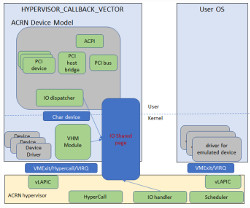Open source project aims to build embedded Linux hypervisor
Mar 14, 2018 — by Eric Brown 3,133 views The Linux Foundation announced an Intel-backed embedded reference hypervisor project called “ACRN” that features real-time and safety-critical features for Linux and Android IoT and automotive projects.
The Linux Foundation announced an Intel-backed embedded reference hypervisor project called “ACRN” that features real-time and safety-critical features for Linux and Android IoT and automotive projects.
At the Embedded Linux Conference in Portland, Oregon, the Linux Foundation announced a project called ACRN (like “acorn”) based on Intel technology that will develop a lightweight, open source embedded reference hypervisor. Licensed with the permissive BSD-3-Clause, the technology supports a variety of IoT applications including automotive.

ACRN architecture
(click image to enlarge)
ACRN is comprised of a hypervisor and a device model that provides “rich I/O mediators,” and is designed “with real-time and safety-criticality in mind,” says the Linux Foundation. The hypervisor aims to consolidate “a diverse set of IoT workloads with mixed-criticality on to a single platform,” says the non-profit Linux advocacy organization. ACRN will have a safety/security critical domain with a Linux-based “Service OS,” as well as a non-safety critical domain that hosts guest operating systems such as another Linux instance, an RTOS, Android, or other OSes including Windows.
The ACRN hypervisor will have only about 25K lines of code vs. 156K for a typical datacenter hypervisor, thereby making it more suitable for constrained devices, says the LF. The hypervisor will offer low latency, fast boot time, and prioritization and isolation of safety critical workloads. ACRN can virtualize specific IoT development functions including graphics, imaging, and audio.
— ADVERTISEMENT —
You’ve got to keep ‘em separated
Although ACRN is targeted at wide variety of IoT applications, the one example offered was for “electronic control unit (ECU) consolidation in automotive,” which is explored in-depth on the project’s GitHub page. Automotive is typically where we hear about virtualization in the embedded space: You don’t want your Linux infotainment computer interfering with critical telematics systems.
Only one of the five founding members of ACRN — Aptiv — is dedicated primarily to automotive technology. The others are Intel, Adlink, LG, and Chinese IT services giant Neusoft.


Typical ACRN architecture for automotive virtualization (left) and ACRN device model architecture
(click images to enlarge)
The Linux Foundation notes that there are open source hypervisor options available, but says that none are truly suited for embedded. The LF is most likely referring to the Xen Hypervisor.
Back in 2014, the Xen Project announced an Embedded and Automotive initiative in association with the Linux Foundation’s Automotive Grade Linux (AGL) project to bring its hypervisor to a GlobalLogic IVI stack combining a fast-boot Android with Linux or QNX. Yet last August when the AGL announced a Virtualization Expert Group (EG-VIRT), there was no mention of Xen. It’s unclear if EG-VIRT will be collaborating with ACRN.
Further information
The ACRN project is looking for new members and developer participation. More information may be found at the Linux Foundation’s ACRN website and ACRN GitHub page.
Sound Open Firmware
The Linux Foundation also announced that Sound Open Firmware (SOF) has become a Linux Foundation project, also backed by Intel. With significant engineering and code contributions from Intel, SOF includes a digital signal processing (DSP) firmware and an SDK that together provide infrastructure and development tools for developers working on audio or signal processing. Intel and Google support SOF and invite others to join them in advancing the project.
The project is the first fully open source BSD/MIT-licensed audio firmware. The SOF firmware and drivers are platform- and architecture-agnostic. The SOF open source SDK comes with five components: the firmware source code, firmware tools to convert firmware into appropriate formats and debug, a tool chain for firmware image creation, an emulator to trace and debug drivers and firmware, and ASoC Linux kernel drivers that are required to register the DSP and firmware. These tools include scripts to help developers evaluate tradeoffs between memory, audio quality, and processor load. SOF will provide code signature tools for production devices. Google contributed GNU Debugger integration to this project. For more information visit www.sofproject.org

Please comment here...